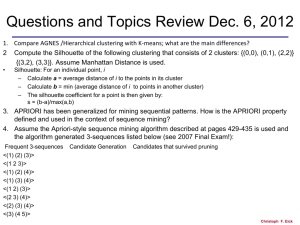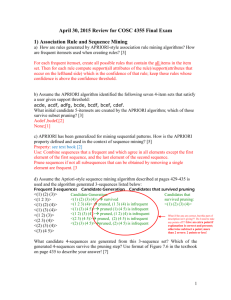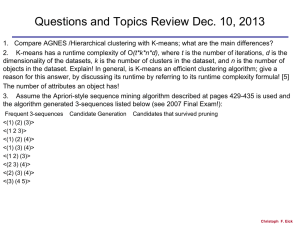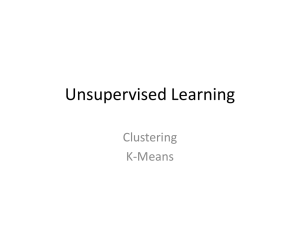Questions December 1
advertisement
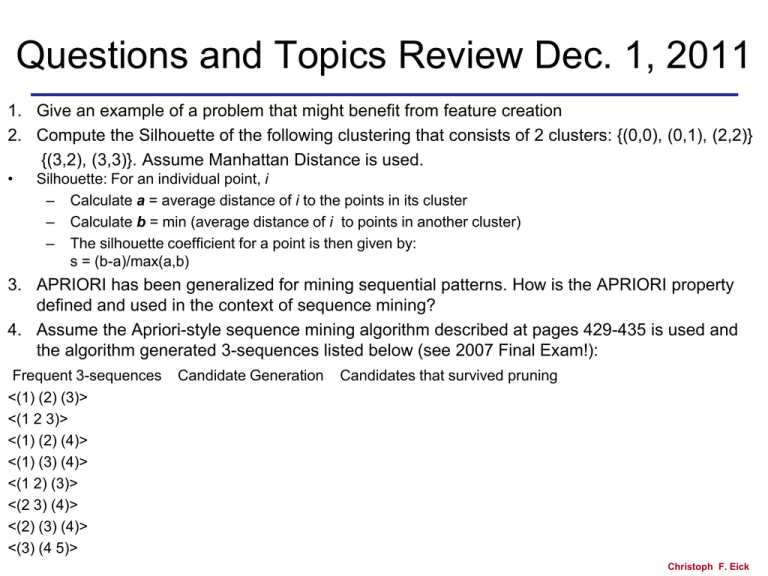
Questions and Topics Review Dec. 1, 2011
1. Give an example of a problem that might benefit from feature creation
2. Compute the Silhouette of the following clustering that consists of 2 clusters: {(0,0), (0,1), (2,2)}
{(3,2), (3,3)}. Assume Manhattan Distance is used.
•
Silhouette: For an individual point, i
– Calculate a = average distance of i to the points in its cluster
– Calculate b = min (average distance of i to points in another cluster)
– The silhouette coefficient for a point is then given by:
s = (b-a)/max(a,b)
3. APRIORI has been generalized for mining sequential patterns. How is the APRIORI property
defined and used in the context of sequence mining?
4. Assume the Apriori-style sequence mining algorithm described at pages 429-435 is used and
the algorithm generated 3-sequences listed below (see 2007 Final Exam!):
Frequent 3-sequences
<(1) (2) (3)>
<(1 2 3)>
<(1) (2) (4)>
<(1) (3) (4)>
<(1 2) (3)>
<(2 3) (4)>
<(2) (3) (4)>
<(3) (4 5)>
Candidate Generation
Candidates that survived pruning
Christoph F. Eick
Questions and Topics Review Dec. 1, 2011
1. Give an example of a problem that might benefit from feature creation
2. Compute the Silhouette of the following clustering that consists of 2 clusters: {(0,0), (0,1), (2,2)}
{(3,2), (3,3)}.
•
Silhouette: For an individual point, i
– Calculate a = average distance of i to the points in its cluster
– Calculate b = min (average distance of i to points in another cluster)
– The silhouette coefficient for a point is then given by:
s = (b-a)/max(a,b)
3. APRIORI has been generalized for mining sequential patterns. How is the APRIORI property
defined and used in the context of sequence mining?
• Property: see text book [2]
• Use: Combine sequences that a frequent and which agree in all elements except the first element of the
first sequence, and the last element of the second sequence.
• Prune sequences if not all subsequences that can be obtained by removing a single element are frequent.
[3]
3. Assume the Apriori-style sequence mining algorithm described at pages 429-435 is used and
the algorithm generated 3-sequences listed below:
Frequent 3-sequences
<(1) (2) (3)>
<(1 2 3)>
<(1) (2) (4)>
Candidate Generation
Candidates that survived pruning
Christoph F. Eick
Questions and Topics Review Dec. 1, 2011
3. Assume the Apriori-style sequence mining algorithm described at pages 429-435 is used and
the algorithm generated 3-sequences listed below:
Frequent 3-sequences Candidate Generation Candidates that survived pruning
• 3) Association Rule and Sequence Mining [15]
• a) Assume the Apriori-style sequence mining algorithm described at pages 429-435 is used and
the algorithm generated 3-sequences listed below:
• Candidates that survived pruning:
• <(1) (2) (3) (4)>
•
• Candidate Generation:
• <(1) (2) (3) (4)> survived
• <(1 2 3) (4)> pruned, (1 3) (4) is infrequent
• <(1) (3) (4 5)> pruned (1) (4 5) is infrequent
• <(1 2) (3) (4)> pruned, (1 2) (4) is infrequent
• <(2 3) (4 5)> pruned, (2) (4 5) is infrequent
• <(2) (3) (4 5)>pruned, (2) (4 5) is infrequent
•
•
Christoph F. Eick
•
Questions and Topics Review Dec. 1, 2011
5. The Top 10 Data Mining Algorithms article says about k-means “The greedy-descent nature of kmeans on a non-convex cost also implies that the convergence is only to a local optimum, and
indeed the algorithm is typically quite sensitive to the initial centroid locations…The local minima
problem can be countered to some extent by running the algorithm multiple times with
different initial centroids.” Explain why the suggestion in boldface is a potential solution to the
local maximum problem. Propose a modification of the k-means algorithm that uses the suggestion!
Christoph F. Eick
5. The Top 10 Data Mining Algorithms article says about k-means “The greedy-descent nature of kmeans on a non-convex cost also implies that the convergence is only to a local optimum, and
indeed the algorithm is typically quite sensitive to the initial centroid locations…The local minima
problem can be countered to some extent by running the algorithm multiple times with
different initial centroids.” Explain why the suggestion in boldface is a potential solution to the
local maximum problem. Propose a modification of the k-means algorithm that uses the suggestion!
Using k-means with different seeds will find different local maxima of K-mean’s objective
function; therefore, running k-means with different initial seeds that are in proximity of
different local maxima will produce alternative results.[2]
Run k-means with different seeds multiple times (e.g. 20 times), then compute the SSE
of each clustering, return the clustering with the lowest SSE value as the result. [3]
Christoph F. Eick
